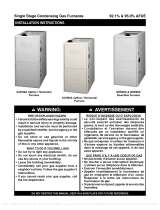
2
TABLE OF CONTENTS
IMPORTANT SAFETY INFORMATION .............................. 3
REQUIREMENTS & CODES .............................................. 4
GENERAL INFORMATION ................................................. 5
Before you install this unit ............................................................ 5
Locating the Equipment ............................................................... 5
Heating Load ................................................................................ 5
COMBUSTION AIR & VENTING REQUIREMENTS .......... 5
Vent Termination .......................................................................... 6
CIRCULATING AIR SUPPLY ............................................. 7
Air Ducts ...................................................................................... 7
Unconditioned Spaces ................................................................. 7
Acoustical Duct Work ................................................................... 7
UNIT INSTALLATION ......................................................... 7
Packaging Removal ..................................................................... 7
Rigging & Hoisting ....................................................................... 7
Clearances to Combustible Materials .......................................... 8
Ground Level ............................................................................... 8
Rooftop ........................................................................................ 8
Horizontal to Downflow Conversion ............................................. 9
Condensate Drain (Air Conditioning) ........................................... 9
Air Filter Requirements ................................................................ 9
Removal of Internal Filter Rack .................................................... 9
Installing Filters in the Internal Filter Rack ................................... 9
1” to 2” Filter Conversion ......................................................... 9
Removing Filters from Internal Filter Rack ................................... 10
ELECTRICAL WIRING ....................................................... 11
Pre-Electrical Checklist ................................................................ 11
Grounding .................................................................................... 11
Line Voltage ................................................................................. 11
Unbalanced 3-Phase Supply Voltage .......................................... 12
Thermostat / Low Voltage Connections ....................................... 12
2-Stage Heat / 1-Stage Cool Thermostat ................................ 12
Single Stage Heat / Single Stage Cool Thermostat ................ 12
Heat Anticipator ........................................................................... 13
Cooling Configurations ................................................................. 13
Heating Configurations ................................................................ 13
Blower Speed ............................................................................... 13
Configuring the Fixed Speed Blower ....................................... 13
Selecting Cooling Airflow ......................................................... 13
Selecting Heating Airflow ........................................................ 13
Dehumidification Options ............................................................. 14
Optional Furnace Control Board Connections ............................. 14
Electronic Air Cleaner .............................................................. 14
Humidifier ................................................................................ 14
GAS SUPPLY & PIPING ..................................................... 15
Leak Check .................................................................................. 15
High Altitude Conversion - Natural Gas ....................................... 16
LP / Propane Gas Conversion ..................................................... 16
START UP & ADJUSTMENTS ........................................... 18
Pre-Start Check List ..................................................................... 18
Start-Up Procedure ...................................................................... 18
Air Circulation .......................................................................... 18
Lighting the Appliance ............................................................. 18
Verifying System Heating ........................................................ 19
Verifying & Adjusting Temperature Rise ................................. 19
Gas Supply Pressure Verification & Adjustment ..................... 19
Verifying the Firing Rate of the Appliance ............................... 19
Measuring the Manifold Pressure ............................................ 20
Adjusting the Manifold Pressure .............................................. 20
Removing the Manometer/Pressure Gauge ............................ 20
Verifying Over-Temperature Limit Control Operation .............. 20
Verifying Burner Operation ...................................................... 21
Verifying System Cooling ........................................................ 21
OPERATING SEQUENCE .................................................. 21
Heating Mode ............................................................................... 21
Thaw Cycle Start Up / Shutdown ................................................. 22
Blocked Vent / Condensate Disposal Shut Down ........................ 23
Cooling Mode - Single Stage Operation ...................................... 23
De-Humidification Control ............................................................ 23
Fan Mode ..................................................................................... 23
COMPONENT FUNCTIONS ............................................... 23
EQUIPMENT MAINTENANCE ............................................ 24
Heat Exchanger & Burner Maintenance ...................................... 24
Cleaning of Burners ..................................................................... 25
REPLACEMENT PARTS .................................................... 25
TROUBLESHOOTING ........................................................ 25
Cooling Mode ............................................................................... 25
Heating Mode ............................................................................... 25
FIGURES & TABLES .......................................................... 26
Figure 8. Unit Dimensions ....................................................... 26
Table 7. Center of Gravity & Shipping Weights ....................... 27
Airflow Information .................................................................... 28
Table 8. Cooling Airflow Settings ............................................ 28
Table 9. Heating Airflow Settings ............................................ 28
Table 10. Blower Performance - 2 & 2.5 Ton .......................... 29
Table 11. Blower Performance - 3 Ton ................................... 30
Table 12. Blower Performance - 3.5 Ton ................................ 31
Table 13. Blower Performance - 4 & 5 Ton ............................. 32
Gas Information ......................................................................... 33
Table 14. Gas Pipe Capacities ................................................ 33
Table 15. Gas Flow Rates ....................................................... 33
Figure 9. Gas Valve Label ....................................................... 34
Electrical Data ............................................................................ 35
Table 16. Electrical Data. ........................................................ 35
Table 17. Copper Wire Size .................................................... 35
Table 18. Thermostat Wire Gauge .......................................... 35
Electrical Diagrams .................................................................... 36
Figure 10. Two Stage Heating / Single Stage Cooling
Configuration .......................................................... 36
Figure 11. Fixed Speed Motor Control Board .......................... 36
Figure 12. Ignition Control Board - 624817 ............................. 36
Wiring Diagrams ........................................................................ 37
Figure 13. Single Phase, 2-5 Ton, 208/230V ......................... 37
Figure 14. Three Phase, 3-5 Ton, 208/230V ........................... 38
Figure 15. Three Phase, 3-5 Ton, 460V .................................. 39
Charging Charts ......................................................................... 40
Figure 16. Charging Chart for 2 Ton Units .............................. 40
Figure 17. Charging Chart for 2.5 Ton Units ........................... 40
Figure 18. Charging Chart for 3 Ton Units .............................. 41
Figure 19. Charging Chart for 3.5 Ton Units ........................... 41
Figure 20. Charging Chart for 4 Ton Units .............................. 42
Figure 21. Charging Chart for 5 Ton Units .............................. 42
Internal Filter Conversion ......................................................... 43
Figure 22. Filter Comversion ................................................... 43
APPENDIX A - HEAT EXCHANGER CONDENSATE
DRAIN & VENT KIT (HORIZONTAL MOUNT
APPLICATIONS) ................................................................. 44
About the Kit ................................................................................ 44
Vent Pipe & Drain Hose Assembly .............................................. 44
Vertical Drain Pit Method ............................................................. 44
Preparing the pit ...................................................................... 45
Percolation Test (Optional) ...................................................... 45
Vertical Drain Pipe Installation ................................................ 45
Horizontal Drain Trench Method .................................................. 45
Preparing the Trench ............................................................... 46
Horizontal Drain Pipe Installation ............................................ 46
Completing the Vent Installation .................................................. 46
APPENDIX B - HEAT EXCHANGER CONDENSATE
DRAIN & VENT KIT (ROOF CURB MOUNT
APPLICATIONS) ................................................................. 48
About the Kit ................................................................................ 48
Before Setting unit on the Curb .................................................... 48
Setting the Unit ............................................................................ 49
Completing the Heat Exchanger Condensate Drain Installation .. 49
Completing the Vent Pipe Installation and Assembly .................. 49
INSTALLATION CHECKLIST ............................................. 52




















